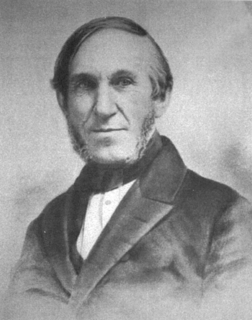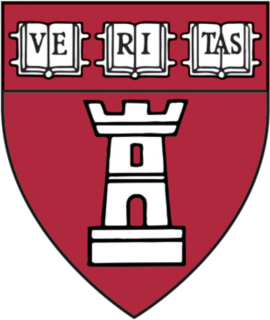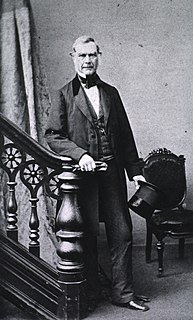Related Research Articles

Harvard Medical School (HMS) is the graduate medical school of Harvard University and is located in the Longwood Medical Area of Boston, Massachusetts. Founded in 1782, HMS is one of the oldest medical schools in the United States and is consistently ranked first for research among medical schools by U.S. News & World Report. Unlike most other leading medical schools, HMS does not operate in conjunction with a single hospital but is directly affiliated with several teaching hospitals in the Boston area. Affiliated teaching hospitals and research institutes include Dana–Farber Cancer Institute, Massachusetts General Hospital, Brigham and Women's Hospital, Beth Israel Deaconess Medical Center, Boston Children's Hospital, & McLean Hospital.

The Boston Brahmins or Boston elite are members of Boston's traditional upper class. They are often associated with Harvard University; Anglicanism; upper-class clubs such as the Somerset in Boston, the Knickerbocker in New York City, the Metropolitan in Washington, D.C., and the Pacific-Union Club in San Francisco; and traditional Anglo-American customs and clothing. Descendants of the earliest English colonists are typically considered to be the most representative of the Boston Brahmins. They are considered White Anglo-Saxon Protestants.

Roger Wolcott was a Republican lawyer and politician from Massachusetts. He was Lieutenant Governor of Massachusetts from 1893 to 1897, becoming Acting Governor in 1896 upon the death of Governor Frederic T. Greenhalge. He was elected governor in his own right in 1897, serving until 1900. He was a leading figure in the Young Republican Club, which revitalized the Massachusetts Republican Party in the 1890s.

Augustus Addison Gould was an American conchologist and malacologist.

The Harvard School of Dental Medicine (HSDM) is the dental school of Harvard University. It is located in the Longwood Medical Area in Boston, Massachusetts. In addition to the DMD degree, HSDM offers specialty training programs, advanced training programs, and a PhD program through the Harvard Graduate School of Arts and Sciences. The program considers dentistry a specialty of medicine. Therefore, all students at HSDM experience dual citizenship between Harvard School of Dental Medicine and Harvard Medical School. Today, HSDM is the smallest school at Harvard University with a total student body of 280.

John Collins Warren, was an American surgeon. In 1846 he gave permission to William T.G. Morton to provide ether anesthesia while Warren performed a minor surgical procedure. News of this first public demonstration of surgical anesthesia quickly circulated around the world. He was a founder of the New England Journal of Medicine and was the third president of the American Medical Association. He was the first Dean of Harvard Medical School and a founding member of the Massachusetts General Hospital.
Nathan Cooley Keep (1800–1875) was a pioneer in the field of dentistry, and the founding Dean of the Harvard School of Dental Medicine.

First university in the United States is a status asserted by more than one U.S. university. Historically, when the Philippines was still a United States territory, the University of Santo Tomas was considered the oldest university under the American flag. Presently in the United States, there is no official definition of what entitles an institution to be considered a university versus a college, and the common understanding of university has evolved over time. The 1911 Encyclopædia Britannica tells the story of the gradual emergence of U.S. "universities" thus:
In the United States the word university has been applied to institutions of the most diverse character, and it is only since 1880 or thereabouts that an effort has been seriously made to distinguish between collegiate and university instruction; nor has that effort yet completely succeeded. Harvard, William and Mary, and Yale. .. were organized. .. on the plans of the English colleges which constitute the universities of Oxford and Cambridge. Graduates of Harvard and Yale carried these British traditions to other places, and similar colleges grew up in New York, New Jersey, Pennsylvania, New Hampshire and Rhode Island.... Around or near these nuclei, during the course of the 19th century, one or more professional schools were frequently attached, and so the word university was naturally applied to a group of schools associated more or less closely with a central school or college. Harvard, for example, most comprehensive of all, has seventeen distinct departments, and Yale has almost as many. Columbia and Penn have a similar scope. In the latter part of the 19th century Yale, Columbia, Princeton and Brown, in recognition of their enlargement, formally changed their titles from colleges to universities.

Massachusetts Eye and Ear is a specialty hospital located in Boston, Massachusetts, United States, which focuses on ophthalmology (eye), otolaryngology (ear/nose/throat), and related medicine and research. Founded in 1824 as the Boston Eye Infirmary (BEI), it has also been known as the Massachusetts Charitable Eye and Ear Infirmary (MCEEI), and Massachusetts Eye and Ear Infirmary (MEEI). It is a teaching partner of Harvard Medical School.

Boylston Street is a major east–west thoroughfare in the city of Boston, Massachusetts. The street begins in Boston's Chinatown neighborhood, forms the southern border of the Boston Public Garden and Boston Common, runs through Back Bay, and ends in Boston's Fenway neighborhood.

New York Eye and Ear Infirmary of Mount Sinai (NYEE) is located at East 14th Street and Second Avenue in lower Manhattan, New York City. Founded on August 14, 1820, NYEE is America's first specialty hospital and one of the most prominent in the fields of ophthalmology and otolaryngology in the world, providing primary inpatient and outpatient care in those specialties. Previously affiliated with New York Medical College, as of 2013 it is affiliated with the Icahn School of Medicine at Mount Sinai as a part of the membership in the Mount Sinai Health System.

Jacob Bigelow was an American physician, botanist and botanical illustrator. He was architect of Mount Auburn Cemetery in Cambridge, Massachusetts, husband to Mary Scollay, and the father of physician Henry Jacob Bigelow. The standard author abbreviation Bigelow is used to indicate this person as the author when citing a botanical name.
The Illinois Eye & Ear Infirmary (IEEI) is a center of ophthalmology and otolaryngology research and clinical practice. Currently, the National Institutes of Health (NIH) ranks the department 4th nationally in ophthalmology research funding and 1st in the Midwestern United States and Chicago metropolitan area.

New England Female Medical College (NEFMC), originally Boston Female Medical College, was founded in 1848 by Samuel Gregory and was the first school to train women in the field of medicine. It merged with Boston University to become the Boston University School of Medicine in 1874.
Samuel Kneeland was a naturalist of the United States.

William Fiske Whitney was an American anatomist, curator, and pathologist. Whitney was a pioneer in the field of the medical museum and originator of the method of quick diagnosis. An obituary describes him as "another of those early pioneers in pathology and the use of the microscope on this continent of whom his contemporaries, the late Sir William Osler and Prof. William H. Welch are notable examples." He specialized in anatomy, becoming one of the top experts in the country. Later, he was much sought after by the courts for his exceptional anatomical knowledge, especially in determining if poison had any bearing on a case.

The Boston Society for Medical Improvement was an elite society of Boston physicians, established in 1828 for "the cultivation of confidence and good feeling between members of the profession; the eliciting and imparting of information upon the different branches of medical science; and the establishment of a Museum and Library of Pathological Anatomy". It held regular meetings until at least 1917.

Samuel J. Lin is an associate professor of surgery at Harvard Medical School and a plastic surgeon at Beth Israel Deaconess Medical Center. He is also the Program Director for the BIDMC/Harvard Plastic Surgery Residency Training Program and Co-Fellowship Director for the Aesthetic and Reconstructive Fellowship Program.

John Jeffries II was an American ophthalmic surgeon who co-founded the Massachusetts Charitable Eye and Ear Infirmary in 1824 with Edward Reynolds. This organization, which began life as the Boston Eye Infirmary, became officially incorporated in 1826 and maintained that name until 1924 when it became Massachusetts Eye and Ear. Jeffries and Reynolds were the only surgical staff until 1833 when the staff was expanded to include other assistant surgeons as well as an apothecary. Jeffries resigned from this position 1842 and had no other official interaction with the institution until his son Benjamin was named Surgeon of the Infirmary in 1867.
References
- ↑ "1847 Chap. 0142. An Act To Incorporate The Boylston Medical School". State Library of Massachusetts. 1847. Retrieved 24 May 2019.
- 1 2 3 Suffolk District Medical Society (1892). Henry I. Bowditch, M. D.: Memorial Meeting. Boston. pp. 8-9.
- 1 2 3 Harrington, Thomas Francis; Mumford, James Gregory (1905). The Harvard Medical School: a history, narrative and documentary, 1782-1905 /. New York: Lewis Publishing Co. pp. 501-505.
- 1 2 Snyder, Charles (1984). Massachusetts Eye and Ear Infirmary: Studies on its history. Boston: Massachusetts Eye and Ear Infirmary. pp. 176-177.
- ↑ Packard, Francis Randolph (1963). History of medicine in the United States . New York: Hafner Pub. Co. p. 447.